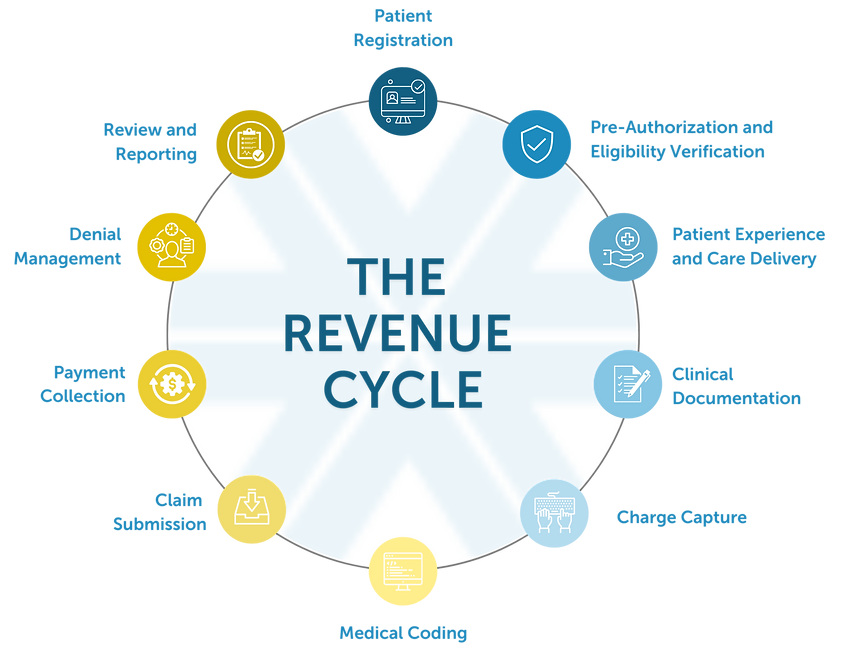
Healthcare Revenue Cycle Management (RCM): A Blueprint for Success
July 15, 2024
In 2024, approximately 40% of U.S. hospitals are still losing money, a slight improvement from previous years but still indicating significant financial challenges in the sector. This reflects ongoing struggles with rising costs and operational inefficiencies despite some recovery in overall hospital operating margins.
In response to these financial difficulties, many healthcare organizations have intensified their focus on healthcare revenue cycle management (RCM) strategies. The global RCM market size was estimated at $306.8 billion in 2023, driven by the need to optimize healthcare revenue streams and manage the increasing volume of patient data.
These findings underscore the continued economic pressures on healthcare institutions and the critical role of effective financial management strategies in navigating these challenges.
In the following blog, we'll delve deeper into what RCM is in the healthcare sector, and how organizations are implementing it to optimize their revenue cycles and ensure sustainable financial health.
Table of Contents
- Understanding Healthcare Revenue Cycle Management
- What is RCM?
- The RCM Process
- Benefits of Effective RCM
- Best Practices
Understanding Healthcare Revenue Cycle Management (RCM)
Healthcare revenue cycle management encompasses all administrative and clinical functions that contribute to capturing, managing, and collecting patient service revenue.
Revenue cycle management, meaning the entire process of financial transactions from a patient's initial appointment to the final bill payment, includes collecting funds from both patients and payers. Healthcare organizations can use it to streamline billing and money-generating operations.
As a healthcare provider, you must navigate a series of complex steps to capture revenue, including:
- Registering patients
- Providing pricing and billing for patient care
- Submitting claims
- Charge capture
- Addressing denials
- Billing individuals and payers
Each step is critical in ensuring accurate and timely medical billing in healthcare facilities.
An efficient claim submission and billing process is critical to organizational continuity. Healthcare providers must also have protocols for addressing claim denials, which will help minimize lost money and optimize cash flow. Insurance companies have entire teams dedicated to denial management, and providers must do the same.
You should strive to avoid denials altogether whenever possible. While that’s easier said than done, a proactive approach to denial prevention will certainly cut down on how many claims get kicked back.
What Is RCM? Unpacking the Basics
Healthcare revenue cycle management is all about optimizing the collection of payer and patient payments. Organizations with the most efficient revenue cycle management processes will quickly move from care delivery to claims processing and payment collection. The goal is to minimize delays and maximize reimbursement for services rendered.
Managing billing and payment processes is integral to the healthcare industry, affecting everything from the patient experience to the organization’s bottom line. Health systems use these workflows to bridge the gap between clinical care and financial operations, ensuring that their providers are able to continue offering quality care without financial hindrance.
The RCM Process: From Patient Encounter to Reimbursement
In order to fully define RCM and understand billing and payment workflows, it’s important to understand the complete process.
The revenue cycle itself begins when a patient schedules an appointment or walks into a hospital and ends when the final bill is paid and a report has been made to reflect on the efficiency of the process.
Here’s a breakdown of the revenue cycle and how RCM supports each step.

Patient Registration
The start of the revenue cycle is when a patient schedules an appointment or walks into a healthcare facility for the first time. This is when patient demographic information is documented and a medical record number (MRN) is assigned to the patient, ensuring the facility remains compliant with clinical and financial regulations.
Pre-Authorization and Eligibility Verification
Upon registration, patient insurance information is collected by the healthcare provider, and coverage is verified. This helps to ensure the patient is billed the correct amount, that they are aware of any out-of-pocket costs, and that the bill is directed to the proper insurance provider (or patient).
Patient Experience and Care Delivery
While clinicians provide direct care to the patients, revenue cycle management teams work to ensure patients receive exceptional customer service, their care plan is communicated, treatments offered to them are covered by insurance, a safe timely discharge plan is arranged, and they are satisfied with the care they receive.”
Clinical Documentation
This is a critical step in the revenue cycle, wherein details of the patient, their visit, and all necessary details are documented swiftly, correctly, and according to regulatory standards. This is not only vital to patient care in the way that symptoms, warning signs, and the like are tracked – but also essential for billing and insurance tracking. Improper, missing, or incorrect documentation can impact the care a patient receives or result in unbilled medical services and more out-of-pocket expenses for the patient.
Charge Capture
During charge capture, healthcare providers record and submit the details of the medical services they provide to individuals. This process ensures that the patient account accurately reflects all services rendered. Effective charge capture is essential for preventing revenue leakage, wherein services provided are not billed or are underbilled due to lapses in documentation.
Medical Coding
Medical coders use the information documented during the patient’s encounter and properly code the services and procedures. This determines how much reimbursement the provider will receive from the patient’s insurance and prevents claim denials.
Claim Submission
At this step, services and procedures are broken down into billable charges and sent to the patient’s insurance provider in a timely manner. The previous steps of the revenue cycle are vital to ensuring this step goes smoothly for all parties involved.
Payment Collection
If the payment is approved by the patient’s insurance provider, the healthcare facility will be reimbursed in accordance with the patient’s eligibility. If a balance remains, the healthcare facility will send that bill to the patient and manage the process going forward.
Denial Management
Denial management is a subsequent phase where healthcare organizations address and resolve claims that have been denied by insurance coverage. This involves identifying the reasons for the denial, correcting any errors or discrepancies, and resubmitting the claims for reconsideration. Effective denial management is crucial for minimizing financial losses and improving the rate of successful claim reimbursements.
Reviewing and Reporting
While the bill may be paid, the revenue cycle is not quite over. The final step in the process is to perform a utilization review, examining whether the services the patient received were necessary, where resources may have been wasted, and how the cycle can be optimized to minimize unnecessary expenses on the sides of the patient and healthcare provider.
After the reviewing and reporting stage, organizational decision-makers will be able to review their strategies and identify recurring issues that may be impeding revenue management efficiency.
For instance, a particular service might have a high denial rate. In that case, the organization needs to find out why and make necessary adjustments to improve profitability. The goal is to maximize revenue cycle visibility so that business leaders can make informed decisions and capture the most revenue possible from insurance companies.
Benefits of Effective RCM in Healthcare
Effective Revenue Cycle Management (RCM) employees are paramount for organizational success. By adding talented RCM staff, healthcare facilities can capitalize on benefits such as:
1. Improved Revenue Capture and Cash Flow
One of the key benefits of optimizing your cycles is better revenue capture and cash flow. A streamlined revenue cycle will mean fewer denials and higher repayment rates. Moreover, a modernized workflow decreases the gap between the time services are rendered and payment remittance.
Simply getting claims paid is not enough. Healthcare organizations need to ensure that invoices are being paid in a timely manner so that they are not waiting months to receive outstanding revenue. Timely and consistent payments strengthen cash flow and promote business continuity.
2. Enhanced Billing and Coding Accuracy
Effective RCM processes improve the accuracy of billing and coding, which is crucial for minimizing claim rejections and denials. By employing sophisticated coding software and regularly training staff on the latest coding standards, organizations can ensure that claims are submitted correctly the first time.
3. Streamlined Operations and Reduced Costs
Effective workflows contribute to the streamlining of operations across the healthcare organization. By automating different stages of the revenue cycle, healthcare providers can reduce the time and labor involved in these processes. Automation helps eliminate manual errors and reduces the need for rework.
4. Compliance and Risk Mitigation Audits
Compliance with healthcare regulations and policies is a significant concern for healthcare organizations. Once you’ve got a great system and set of rules in place, you can use data analytics and audits to ensure best practices are in place for compliance.
Best Practices for Successful Healthcare RCM
If you want to make sure your organization wins at billing and payment collection, you need to use proven best practices. The goal is to transition from services rendered to cash in hand as quickly as possible. To achieve that, you should:
- Automate where possible
- Get rid of manual processes
- Train your workers
- Invest in new tech
You aren’t going to fill all the gaps in your RCM workflow with a single solution. Chances are that you’ll need to make changes in multiple departments to recapture lost cash.
Technology and automation play a crucial role in streamlining RCM processes, reducing manual errors, and increasing efficiency. That’s why you should take advantage of advanced software that seamlessly integrates with your ERHs to help automate registration, eligibility verification, and charge capture. As you continue to automate, you lower the odds of making data entry errors.
The quality of your revenue cycle management staffing will play a critical role in the success of your organization. Make sure that your teams, including receptionists, medical coders, and denial management, are adequately staffed and well-trained.
You should also consider cross-functional education and upskilling to ensure that each group can step into other roles as necessary. For instance, if you experience an uptick in denials due to a payer administrative change, you can reallocate cross-trained medical coders to assist in denial resubmissions.
Finding the Perfect Candidate or Career in RCM
Healthcare revenue cycle management is hard. There is no denying that. However, you’ll be able to master this critical task by using a multifaceted approach.
If you are an organizational leader looking to modernize your healthcare revenue cycle management strategies, explore our staffing solutions and let us connect you with skilled RCM professionals who can help. If you are an RCM professional looking for new challenges, check out our healthcare job opportunities.
From the Experts: Why is Revenue Cycle Management So Important?
To answer this question, we talked to GHR’s director of Compliance for Case Management and Social Services, Patrick O’Boyle, RN, BSN, ACM-RN, CMAC, CCM. Patrick has over 20 years of experience in revenue cycle management and was recently named president of the Florida chapter of the American Case Management Association (ACMA)! Here’s what he had to say:

Revenue cycle management is an essential function of any healthcare provider. It connects the clinical and non-clinical aspects of a patient’s time under the care of a healthcare facility, allowing little opportunity for miscommunication and error across the entire continuum of care. The result is maximized efficiency, improved fiscal well-being of the healthcare provider, streamlined communication between the clinical and non-clinical aspects of the patient experience, and, most of all, high-quality care for patients.

“Our specialty of revenue cycle management is providing you with trusted coding & auditing resources to ensure quality metrics are met or exceeded. We support front-end coding and denial management. From billing to denials management and everything in between, GHR RevCycle can help with supplemental staffing and managed solutions.”
Revenue Cycle Management (RCM) FAQs
Healthcare revenue cycle management (RCM) is the process of handling the financial transactions associated with patient care, from patient scheduling and insurance eligibility verification to claim submission and final payment. The RCM process helps healthcare organizations optimize cash flow, minimize claim denials, and improve patient satisfaction by ensuring timely and accurate medical billing and reimbursement from insurance companies and payers.
RCM is crucial because it ensures that healthcare providers are reimbursed for the services they provide. An efficient RCM process improves cash flow, reduces the risk of denied claims, enhances billing accuracy, and supports the financial health of healthcare organizations. This allows healthcare facilities to continue delivering quality care without financial stress.
The healthcare revenue cycle management process consists of several key steps:
- Pre-registration – Collecting patient demographics and verifying insurance eligibility
- Patient Access & Scheduling – Ensuring proper insurance coverage and estimating patient financial responsibility
- Charge Capture & Medical Coding – Assigning accurate medical codes for billing and reimbursement
- Claim Submission & Processing – Submitting claims to insurance companies and handling claim denials
- Payment Collection & Patient Billing – Managing co-pays, deductibles, and out-of-pocket expenses
- Denial Management & Follow-Up – Resolving billing process issues and tracking accounts receivable
- Remittance & Final Payment – Ensuring timely payment collection and revenue optimization
To streamline the revenue cycle management process, healthcare providers can:
- Use automation for eligibility verification, medical coding, and claims processing
- Implement data analytics to monitor financial performance and reduce bad debt
- Improve patient engagement by offering transparent pricing and flexible payment collection options
- Enhance denial management strategies to minimize claim denials and speed up reimbursement
Advancements in technology help healthcare facilities optimize their RCM process by:
- Integrating electronic health records (EHR) for accurate patient information and insurance verification
- Automating charge capture, billing workflows, and follow-up processes
- Using AI-driven audits to prevent medical billing errors and improve profitability
- Enhancing patient access through self-service portals for insurance eligibility verification and payment collection
To measure the efficiency of revenue cycle management, health systems track key KPIs, including:
- Days in accounts receivable (A/R) – Measures how long it takes to receive final payment
- Clean claim rate – Tracks the percentage of claims submitted without errors
- Denial rate – Measures the percentage of claim denials due to billing or eligibility issues
- Patient collection rate – Evaluates the success of patient payments and co-pays recovery
- Cost to collect – Analyzes expenses related to claims processing, insurance verification, and remittance
To enhance healthcare revenue cycle management, healthcare providers can:
- Improve front-end processes like pre-registration and eligibility verification
- Leverage automation and AI-driven RCM solutions to reduce billing errors
- Implement value-based care models that focus on both patient service and revenue management
- Strengthen contract management with insurance companies to optimize reimbursement rates
Contract management integrates with Oracle Health RevElate Patient Accounting by automating billing workflows, tracking insurance coverage, and ensuring compliance with payer agreements. This integration helps healthcare organizations manage pricing, claims processing, and patient accounts efficiently, reducing denials and improving financial performance.
Subscribe to GHR's Blog Newsletter
Your submission was successful.
Thank you for subscribing — we'll be in touch!





